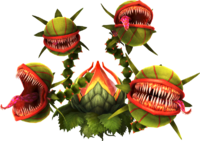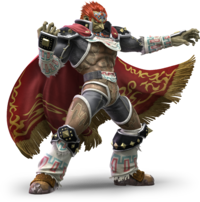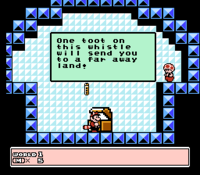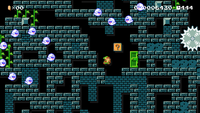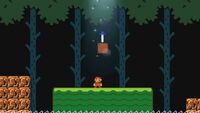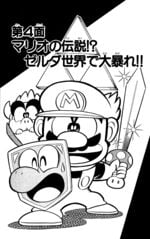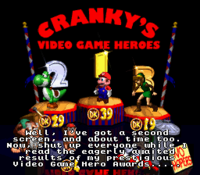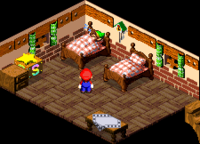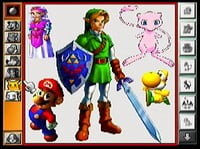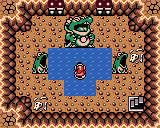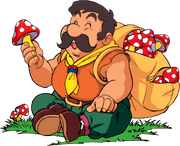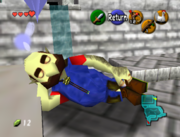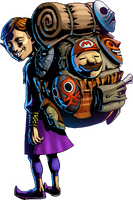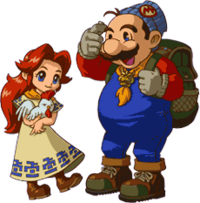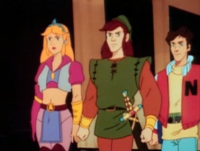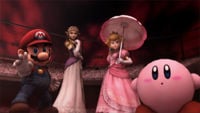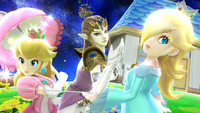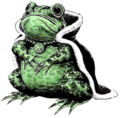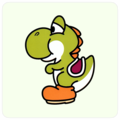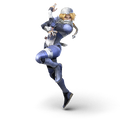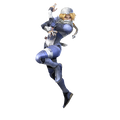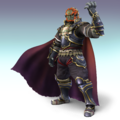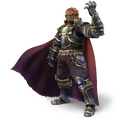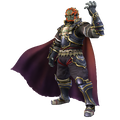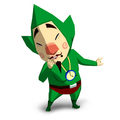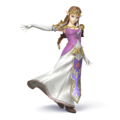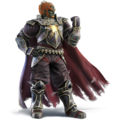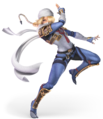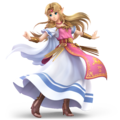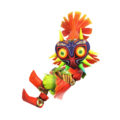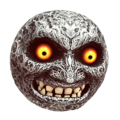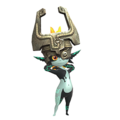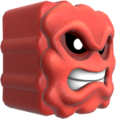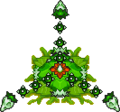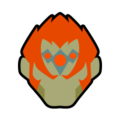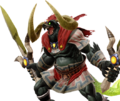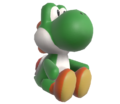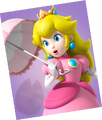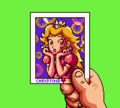User:Nintendo101/community garden
| The Legend of Zelda | |
|---|---|
 Wordmark for The Legend of Zelda franchise used from 2011 to 2016 | |
| First installment | The Legend of Zelda (1986) |
| Latest installment | The Legend of Zelda: Echoes of Wisdom (2024) |
| Series | The Legend of Zelda, Tingle, Hyrule Warriors |
| Related franchises | The Mysterious Murasame Castle, Marvelous Mōhitotsu no Takarajima |
The Legend of Zelda, often referred to as Zelda in shorthand,[citation needed] is a fantasy-themed media franchise primary consisting of video games produced by Nintendo. The main titles are action-adventure games that follow the adventures of Link, a courageous green-clad hero predestined to battle the forces of evil and protect the magical kingdom of Hyrule. In most games, Princess Zelda appears as a deuteragonist, while Ganon is the primary antagonist.
As one of Nintendo's most successful series, The Legend of Zelda franchise has shared synergy with the Super Mario franchise. Both series have had frequent crossovers with and references to each other, such as in the Super Smash Bros. series, and series protagonist Link has made several appearances in the Super Mario franchise itself, including as a playable character in Mario Kart 8.
Overview
- Talk about the synthesis for Zelda, including Miyamoto's childhood, and the context with which its developement occured alongside Super Mario Bros.
- Note the involvement of Mario staff Takashi Tezuka, Koji Kondo, and Yoshiaki Koizumi in shaping Zelda
- Note the shared development history between Mario and Zelda up until the mid-2000s, when there was enough independent staff working on both games
- Provide a franchise overview of what Zelda is, including
- genera as a action-adventure, puzzle-solving fantasy game, with 2D top-down games and sprawling 3D games; provides a different type of experience from mainline Mario
- deviation from other fantasy games like Dragon Quest and Final Fantasy in deemphasizing menu navigation
- the importance of accumulating weapons, keys, tools, and resources in these games, particularly ones associated fnatasy like swords, arrows, magical spells, and fairies
- magical instruments for casting spells, like flutes, ocarinas, and batons
- Hyrule, the fantasy setting, and important places like Death Mountain, the Lost Woods, and Hyrule Castle
- The Zelda timeline/continuity, and the destined relationship between Courage, Wisdom, and Power
- The whimsical nature of the series
- the importance of Zelda to the greater gaming industry and popular culture
- continued synthesis with Mario in Nintendo marketing and tangibly in games
Recurring crossover subjects
Characters
Link
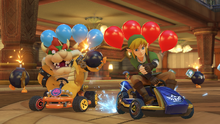
- Main article: Link
Link is the protagonist of The Legend of Zelda series and typically the sole playable character of his games. In most titles, he is tasked with protecting Hyrule from the forces of a rising evil, especially his arch-nemesis Ganon. Link possesses the Triforce of Courage and is capable of using a wide variety of weapons, including bombs, arrows, swords, and shields. There have been many incarnations of Link throughout history, but he typically appears as a blonde green-clad man with pointed, elvish ears. Link was created by Shigeru Miyamoto and has some cursorial similarities to Mario, such as in being largely silent and serving as the analog for the player.[citation needed] Similar to how Mario is the conceptual offshoot of Popeye, Link was derived from another fictional character from Miyamoto's youth - the Walt Disney interpretation of Peter Pan.[citation needed]
In the lore of his series, people who possess the Triforce of Courage are reincarnated once they die, so while there is only one individual Mario, there have been many individual Links.[citation needed] This narrative framework has resulted in widely distinctive designs between individual Links. For example, the Link from The Legend of Zelda: The Wind Waker - an incarnation sometimes called Toon Link - is a young boy with cartoonish proportions and catlike eyes. The Link in The Legend of Zelda: Twilight Princess is a stoic young man, proportionate to real humans and much gridier in aesthetic. Many Zelda games incorporate dueling representations of the world that inform what Link looks like and his abilities. A common motif includes a "light world" and a "dark world." In Twilight Princess, the latter is represented by the Twilight Realm, in which Link is transformed into a beast called Wolf Link. Another recurring concept is a world of the "past" and the "future." In The Legend of Zelda: Ocarina of Time, Link begins the game as a boy called Young Link. At a later point in the game, the Adult Link of the future finds the means to transition back to the past and regress back into a child. A number of Zelda games emphasize multiplayer, in which Link is either split into multiple individuals or encounters doppelgängers also named Link by chance. Each one is a different color. In The Legend of Zelda: Tri Force Heroes, there are three Links that cooperate to form a Totem Link to solve puzzles and progress.
Link has made recurring appearances in the Super Mario franchise, usually only in the form of cameos. However, some of these cameos have Link making physical appearances in the game, as is the case in Super Mario RPG: Legend of the Seven Stars and Donkey Kong Country 2: Diddy's Kong Quest. Mario can take on the appearance of multiple different iterations of Link in Super Mario Maker through use of the Mystery Mushroom, and Link himself is playable in the Super Smash Bros. series, Mario Kart 8, Mario Kart 8 Deluxe, and Super Mario Maker 2. Young Link and Toon Link have also appeared in the Super Smash Bros. series, and the latter appears as a costume in Super Mario Maker as well. Link has otherwise made recurring appearances with Mario in comics and marketing material for Nintendo.
Princess Zelda

- Zelda Wiki article: Princess Zelda
Princess Zelda is the title character of The Legend of Zelda – the ruling princess of Hyrule and a close confidant of Link. Similar to him, the character of Zelda possesses the Triforce of Wisdom and has been reincarnated many times throughout her series' history, meaning there have been many different individuals named Zelda. Her appearance, characterization, and royal status vary by game, but Zelda is generally presented as a thoughtful and reserved blonde princess. Her relationship with Link also varies: some incarnations present them as obligatory allies, close friends, or young lovers. Most The Legend of Zelda titles involve her being kidnapped by Ganon or another adversary in order to take her Triforce, making her analogous to Princess Peach as a damsel in distress. However, unlike Peach, Zelda is often given an active supporting role, sometimes even being a traveling companion or teacher to Link. Zelda is often depicted as well-versed in light magic, telepathy, and the use of powerful weapons called Light Arrows.
Princess Zelda has sometimes disguised herself or taken on alter egos to aide Link, such as Sheik in The Legend of Zelda: Ocarina of Time. Sheik's identity as Zelda is concealed to the player for most of the game, as she is concealed in bandages, appears androgynous in build, and presents herself as a member of the Sheikah. Sheik appears as a playable fighter in the Super Smash Bros. series, starting with Super Smash Bros. Melee. In their first two appearances, Zelda and Sheik could transform into each other during battles, but in later entries, Sheik is an entirely separate character from Zelda. A similar alter ego named Tetra appears in The Legend of Zelda: The Wind Waker, a pirate captain. Narratively similar to Ocarina of Time but distinct from Sheik, she herself did not know she was Princess Zelda until late in the game.
Zelda's presence with Super Mario characters has largely been restricted to the Super Smash Bros. series, the DiC cartoons, and general marketing material. However, Princess Zelda, Sheik, and Tetra appear as Costume Marios in Super Mario Maker. Two incarnations of Zelda appear alongside Princess Peach, Rosalina, and Pauline in the Puzzle Swap panel "Nintendo Starlets" from StreetPass Mii Plaza: one from The Legend of Zelda: Skyward Sword, the other from The Legend of Zelda: Spirit Tracks.
Characters based on Mario and Luigi
There are several non-playable characters directly based off of Mario and Luigi in The Legend of Zelda franchise. The earliest examples are Tarin and the Henhouse Keeper from The Legend of Zelda: Link's Awakening. While these two do not appear outside of remakes of Link's Awakening, their conceptual successors Talon and Ingo are. These two were introduced in The Legend of Zelda: Ocarina of Time as workers on Lon Lon Ranch. The friendly, red-clad Talon is the one based on Mario and he has made subsequent appearances in The Legend of Zelda: Oracle of Seasons, The Legend of Zelda: Four Swords Adventures, The Legend of Zelda: The Minish Cap. Talon has also cameoed in promotional material for Japan Expo 2017 - The Art of The Legend of Zelda Series, and there is an extremely similar-looking bartender in The Legend of Zelda: A Link Between Worlds.
Ingo, Talon's bitter ranch-hand, is the one based on Luigi. His animosity towards Talon may derive from the occasional assertion that Luigi is envious of Mario.[citation needed] After Ocarina of Time, Ingo has appeared in Oracle of Seasons and the spin-off title Freshly-Picked Tingle's Rosy Rupeeland, and he has a lookalike bartending in A Link Between Worlds. Gorman, a character derived from Ingo, appears in The Legend of Zelda: Majora's Mask and The Minish Cap.
Enemies
Octoroks
- Zelda Wiki article: Octorok
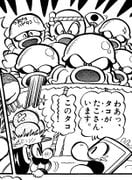
Octoroks are terrestrial octopus enemies in The Legend of Zelda series. Their visual appearances vary by game, but their means of attack is generally the same. They spit projectile rocks at Link that damage him on contact. They walk along the ground in the top-down 2D games, but in the 3D titles, Link often has means of hitting them back. Octoroks are the basis for a number of enemies in the Super Mario franchise, including Octolots and Octovaders from Super Mario RPG: Legend of the Seven Stars, Chuckoroks from Mario & Luigi: Superstar Saga, and various octopus enemies in Super Mario Galaxy and Super Mario Galaxy 2. The original Zelda enemy appears unaltered in Super Mario-kun, WarioWare: Twisted!, Super Smash Bros. Melee, Super Smash Bros. for Nintendo 3DS, Nintendo Land, and NES Remix 2. Their likeness is also featured on a sticker in Super Smash Bros. Brawl and as a spirit in Super Smash Bros. Ultimate.
Super Mario enemies in The Legend of Zelda
Talk about Chain Chomps, Thwimps, Thwomps, Bloopers, Bob-ombs, Bombites, Boos, Cheep Cheeps, Goo Specters (which are Boo Blahs), Guruguru Bars (which are Fire Bars), Lakitu, Piranha Plant, Podoboo (Lava Bubble), Podoboo Tower, Pokey, Shy Guy, and Mamu (Wart)
Bosses
Manhandla
- Main article: Manhandla
Manhandlas are recurring bosses that debuted in The Legend of Zelda franchise. They are enormous, four-headed carnivorous plant capable of sliding across the floor. Manhandlas debuted in the first Legend of Zelda as the boss of Level 3, a middle boss in Level 4, and an enemy in Level 8. They move around the room in an erratic pattern, spitting fireballs from each head in the direction Link is located. Manhandlas are immune to Fire or the Boomerang, and their fireballs cannot be deflected by a Magical Shield item. When Link destroys a head, its movement and attack speed will increase. It is defeated once all its heads are destroyed.
Though some more contemporary appearances depict Manhandlas with designs more comparable to Deku Babas, the Japanese instruction booklet for The Legend of Zelda specifies that they are a type of Piranha Plant.[1] The English localization omitted this detail. Manhandlas represent the first time a Piranha Plant has appeared outside of the Super Mario franchise and are first variant of the enemy. They are also the first Piranha Plant boss, debuting before Naval Piranha by nearly a decade.
Ganon
- Zelda Wiki article: Ganon
Ganon, occasionally referred to as "The Demon King," is the primary antagonist of The Legend of Zelda series. In the canon of his series, Ganon began life as a dark wizard named Ganondorf from the arid Gerudo region. Seeking to take control of Hyrule, Ganondorf stole the Triforce of Power from hallowed grounds. While granting him incredible power, the corruption from this Triforce turned him into a porcine beast. Overtime, it erased all traces of the man he was before, rendering him a mindless monster. Typically, the beastial form of the character is the one called "Ganon," whereas "Ganondorf" is retained solely for his human form. The former is more recurring in The Legend of Zelda and debuted in the first game, whereas the latter has made less consistent appearances but serves more substantive narrative roles when he does appear.
Unlike Link and Zelda, there is only one true Ganon and he has been defeated by Link multiple times, but several adversaries throughout The Legend of Zelda franchise have sought his resurrection. Ganon's past as Ganondorf is alluded to in The Legend of Zelda: A Link to the Past and presented in detail in The Legend of Zelda: Ocarina of Time, which canonically occurs before A Link to the Past. Ganon's relationship to Link and Princess Zelda is comparable to the one between Mario, Princess Peach, and Bowser, though their underlying motives differ. Bowser typically kidnaps Peach out of genuine affection for her. Ganon has no such sentiments for Zelda, who kidnaps her simply to seize her Triforce of Wisdom. Ganon is similar to Bowser in other respects. Both are influenced by characters from Journey to the West, namely the pig-like Zhu Bajie for Ganon. While Bowser's armies are primarily made up of turtles, Ganon controls legions of pig-like monsters called Moblins and Bokoblins. Both Bowser and Ganon were created by Shigeru Miyamoto.
Ganondorf is a playable fighter in Super Smash Bros. Melee and has been integrated into every subsequent Super Smash Bros. title. In Super Smash Bros. Melee, his design is based on his "past" appearance in Ocarina of Time, while in Super Smash Bros. Brawl, Super Smash Bros. for Nintendo 3DS, and Super Smash Bros. for Wii U, he is based on his design in The Legend of Zelda: Twilight Princess. Ganondorf's design in Super Smash Bros. Ultimate is based on his "future" appearance in The Legend of Zelda: Ocarina of Time. He has otherwise made cameo appearances in Super Mario Maker and Yoshi's Woolly World. Though not used as often as Link and Zelda, Ganon has appeared alongside Super Mario characters in marketing material for Nintendo and appears in mutual crossovers like Nintendo Land.
"File Select" / "Fairy Fountain"
Definitely. It comes from SMB3, but was elaborated on in A Link to the Past and is near ubiquitous in its series. It's unique that an artistic element from a mainline Mario game has cemented itself in another series.
History in the Super Mario franchise
Super Mario series
Super Mario Bros. / Super Mario Bros. Deluxe
The original Super Mario Bros. and The Legend of Zelda had some development overlap and were designed by the same staff. The Fire-bars found in the original Super Mario Bros. were originally conceived for Zelda before determining it would work better in Super Mario Bros.[2] Fire-bars eventually were incorporated into The Legend of Zelda: A Link to the Past and some subsequent top-down Zelda titles, under the name of "Guruguru Bars."
Super Mario Bros. 3 / Super Mario Advance 4: Super Mario Bros. 3
The Magic Whistle is a rare item in Super Mario Bros. 3 that is usable on the world map screen. Playing it causes a whirlwind to appear and whisk Mario to the secret Warp Zone. He can skip ahead to another world through the Warp Zone, but which ones are available to him is dependent on whichever world he was already in when he played the Magic Whistle. This item is the Flute from The Legend of Zelda and even plays the same six notes when played. Its functionality is also shared, as the Flute can warp Link to different dungeons in that game. The item returns in the Game Boy Advance remake Super Mario Advance 4: Super Mario Bros. 3 with the same functionality. The Magic Whistle has established its own recurring history in the Super Mario franchise, such as in Paper Mario: Color Splash.
Super Mario Sunshine
Over the course of Super Mario Sunshine, Mario is occasionally challenged to a footrace by Il Piantissimo, a man dressed as a Pianta. His face is masked in the game, but through hacking the game's camera or viewing the Il Piantissimo in a model viewer reveals he resembles the Running Man from The Legend of Zelda: Ocarina of Time.
Super Mario Galaxy
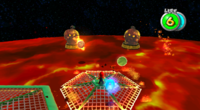
A recurring group of octopus-based enemies are introduced in Super Mario Galaxy. One of them is Rocto – a large gray octopus that spits coconuts at Mario from a fixed distance over empty space. Damaging Roctos requires launching the projectile back at them with a Spin. The means of attack and defeat mirror how Octoroks are defeated in The Legend of Zelda 3D titles. The internal file designation and Japanese name for Rocto indicate this was not circumstantial, and that the enemy is directly based off of them. The Rocto boss King Kaliente attacks similarly, and their diminutive relative Octoguy spits small damaging rocks. Pig-nosed bats also appear in the game that flutter before Mario before swooping down to strike him. Similar to Rocto, their means of attack is similar to that of Keese in the 3D Zelda titles, and its more naturalistic design is comparable to the enemy's appearance in The Legend of Zelda: Twilight Princess. The ice bats similarly are invocative of Ice Keese. Stone torches appear in a few galaxies, like the Freezeflame Galaxy and Deep Dark Galaxy. Lighting all of the torches in an immediate area generally facilitates progression, such as by causing a stone gate to slide away. This function is shared with the torches in The Legend of Zelda series. In the Rolling Gizmo Galaxy, some Star Bits are arranged into a shape resembling a Rupee.
Super Mario Galaxy shares some developmental elements with The Legend of Zelda: The Wind Waker. The skybox texture in the Ghostly Galaxy and Boo's Boneyard Galaxy previously was used for the Ghost Ship dungeon from that game. The dynamic integration of music, where certain jingles and sound effects play differently based on the notes of the background orchestration, was first developed by sound director Masafumi Kawamura for enemy battles in The Wind Waker.[3] According to director Yoshiaki Koizumi, the boss battle with Megaleg derived from an unused concept conceived for The Legend of Zelda: Ocarina of Time, where Ganon would be so large that Link would have to climb up his body.[citation needed]
Super Mario Galaxy 2
Many of the elements in Super Mario Galaxy 2 were incorporated from its predecessor. In addition to the returning Roctos and King Kaliente, a new Rocto boss named Prince Pikante appears that has similar means of attack. The most recurring octopus enemy, Octoombas, now spit rocks to attack just like the returning Octoguys. A new variant called the Elite Octoomba is introduced that spits two rocks at a time.
Producer Shigeru Miyamoto stated that efforts were made to differentiate Super Mario Galaxy 2 from its predecessor in a similar manner to The Legend of Zelda: Majora's Mask, another game structurally derived from its predecessor.[4]
Super Mario 3D Land
The desert-themed underground course World 5-2 in Super Mario 3D Land lampshades 2D entries in the The Legend of Zelda series. Unlike the majority of the other courses in the game, the the camera in World 5-2 is held from a top-down view. Lighting all of the torches in one of the rooms causes a stone door to open, and it is accompanied by the recurring "Puzzle Solve Fanfare" from The Legend of Zelda series.
Super Mario 3D World / Super Mario 3D World + Bowser's Fury
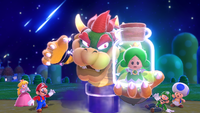
Super Mario 3D World and its Nintendo Switch port prominently feature fairy-like people called Sprixies. Their ruling princesses are captured by Bowser in his effort to conquer the Sprixie Kingdom, and he does so by trapping them in bottles. This is the same way Link traps fairies in The Legend of Zelda series.
Triggering all of the Color Panels on one of the platforms in Rainbow Run triggers the "Item Get" fanfare from The Legend of Zelda before illuminating the whole platform. It is revealed to be a recreation of Link's sprite form the original Legend of Zelda, and the background music of the area changes into an arrangement of the "Main Theme" titled "Link's Color Panels."
Super Mario Maker
Super Mario Maker introduces the Mystery Mushroom for Super Mario Bros.-themed courses. This power-up transforms Mario into Costume Mario, a form that disguises Mario as one of many other fictional character, the majority of which do not originate from the Super Mario franchise. The player has digression into which character the Mystery Mushroom transforms Mario into, but not all of them are available by default. Most costumes can either be unlocked by completing the 100 Mario Challenge on a particular difficulty or by scanning the character's amiibo figure. There are costumes that completely lack amiibos.
9 of the 136 costumes come from The Legend of Zelda: 6 included at launch and 3 included in post-release updates. Most of the characters included at launch are tied to an amiibo figure released for Super Smash Bros. for Nintendo 3DS / Wii U and reflect their designs in that game. For example, the costumes of Zelda and Ganondorf resemble their incarnations from The Legend of Zelda: Twilight Princess. However, the sound-effects corresponding to these characters and their poses are homages to The Legend of Zelda series. The Link costume does not resemble his the Twlight Princess incarnation used in Super Smash Bros., instead resembling the original sprite from the first Legend of Zelda. The only Zelda character available at launch to have lacked an amiibo is Tingle, the map maker from The Legend of Zelda: Majora's Mask. Their numerical order in the costume list matches the order in which they debuted in the Zelda franchise.
2 of the 3 costumes released after the game launched corresponded with games released at the time and have corresponding Event Courses based on those games. Tetra, Zelda's pirate alter-ego from The Legend of Zelda: The Wind Waker, was the only exception. The Event Courses make homages to The Legend of Zelda, partiuclarly the original Famicom Disk System-game in Tri Force Heroes and Twilight Princess in Twilight Princess HD. In addition to these two Event Courses, a course attributed to Undodog was uploaded on 18 December, 2015 titled 3 GAMES IN 1. The three segments of this course are based on different Nintendo games, with the second one based on The Legend of Zelda.
Spike Traps appear as the Sea Urchin enemies from The Legend of Zelda: Link's Awakening when placed in an underwater-themed, Super Mario World-styled course.
- List of costumes from The Legend of Zelda
- Main article: Costume Mario § List of costumes
| # | Image | Costume | Unlock method(s) | Notes |
|---|---|---|---|---|
| 53 | Link | Clear 100 Mario Challenge on Easy or harder or use any Link amiibo | Based on Link's sprite from and uses sound effects from the Famicom Disk System version of the original The Legend of Zelda, including the fanfare for collecting a piece of the Triforce after clearing a course. Upon touching the Mystery Mushroom, the original "Item Get" jingle will play. If the player presses | |
| 54 | Zelda | Clear 100 Mario Challenge on Expert or Super Expert or use any Zelda amiibo | Based on Zelda's appearance in The Legend of Zelda: Twilight Princess rather than her original NES sprite. Upon touching the Mystery Mushroom, the "Item Get" jingle from The Legend of Zelda: A Link to the Past will play. While holding | |
| 55 | Ganondorf | Clear 100 Mario Challenge on Easy or harder or use any Ganondorf amiibo | Based on Ganondorf's appearance in The Legend of Zelda: Twilight Princess. Upon touching the Mystery Mushroom, Ganon's jingle from Ganon's Tower in A Link to the Past will play. When falling in a pit, the sound effect of a boss being defeated from that game will play. When clearing a course, the first few notes of the encounter theme when Link comes face-to-face with Ganon in A Link to the Past plays. | |
| 56 | Sheik | Clear 100 Mario Challenge on Normal or harder or use the Sheik amiibo | Upon touching the Mystery Mushroom, the "Item Get" jingle from The Legend of Zelda: Ocarina of Time will play. While holding | |
| 57 | Tingle | Clear 100 Mario Challenge on Normal or harder | Sounds from The Legend of Zelda: Majora's Mask can be heard: The victory jingle is the tune that plays when the player completes certain time-related events in said game, and the death jingle is one of the tunes that can play when failing certain such events. | |
| 58 | Toon Link | Clear 100 Mario Challenge on Normal or harder or use any Toon Link amiibo | Based on Link's appearance from The Legend of Zelda: The Wind Waker. Upon touching the Mystery Mushroom, the "Item Get" jingle from The Wind Waker plays. Toon Link takes out his Deku Leaf every time he jumps. The death tune is the tune that plays when Link gets caught by Moblins while trying to sneak inside the Forsaken Fortress in The Wind Waker. Pressing | |
| 102 | Totem Link | Clear the Tri Force Heroes Event Course | A pixel art rendition of the three Links of The Legend of Zelda: Tri Force Heroes stacked up into a totem like in the game. Their transformation and course clear sounds are 8-bit renditions of the series' main theme (unique from the other Link's) and the main theme of Tri Force Heroes. Pressing | |
| 132 | Wolf Link | Clear the Twilight Princess HD Event Course or use the Wolf Link amiibo | A sprite rendition of Wolf Link and Midna from The Legend of Zelda: Twilight Princess. It uses the Wolf Link and Midna audio and the theme for the death and goal from Twilight Princess. Touching the Mystery Mushroom makes Wolf Link howl, whilst pressing | |
| 135 | Tetra | Clear 100 Mario Challenge on Normal or harder | A sprite rendition of Tetra from The Legend of Zelda: The Wind Waker. Pressing |
Super Mario Maker 2
In version 2.0.0, what was promoted as "A Legendary Update",[citation needed] the Master Sword was added as a power-up to Super Mario Maker 2. It is only available in the Super Mario Bros.-style, and grabbing it transforms the player character into Link. Unlike Costume Mario from the previous game, this iteration of Link is not a disguise and grants the player unique abilities from The Legend of Zelda series. Link himself resembles his sprite from the original game on the Famicom Disk System. The color of his tunic is informed by the player character that grabs the Master Sword: Mario is green, Luigi is red, Toad is blue, and Toadette is pink. These colors correspond to the color of the playable Links in The Legend of Zelda: Four Swords and its sequels. Unlike the original game, his shield resembles the Hylian Shield, a recurring item in the Zelda series that was introduced in The Legend of Zelda: Ocarina of Time. Link has moves derived from gameplay elements in The Legend of Zelda, including Bombs and Arrows. Link can attack enemies with his sword and protect himself from projectiles with his shield. He can perform the Dash Attack from The Legend of Zelda: A Link to the Past and the Down Thrust from Zelda II - The Adventure of Link. Two official courses were released that heavily feature the Master Sword. The first is The Speedventure of Link, a forest-themed Ninji Speedrun course named after Zelda II. The second course is Link's Lightweight Longshots, released in 2021 to correspond with the release of the Game & Watch: The Legend of Zelda. Though not apparent in the English localization, the Japanese name for this course is a reference to Link's Crossbow Training.
Similar to Superball Mario and SMB2 Mario, the background music and sound effects of the course change while the player character is Link. Most of these pieces hail from the original Legend of Zelda. The "Ground Theme", its arrangements for other above ground courses, and the "Underwater Theme" are replaced with the "Overworld Theme"; the "Underground Theme" and "Ghost House Theme" are replaced with the "Underworld Theme"; and the "Castle Theme" and "Airship Theme" are replaced with "Death Mountain." The Bonus Music sound effect is an original chiptune arrangement of "Horse Race" from The Legend of Zelda: Ocarina of Time. Both Boss Music and Final Boss sound effects come from Zelda II - The Adventure of Link, named "Boss" and "Last Boss", respectively. The Peaceful sound effect is a chiptune rendition of "Select Screen" from The Legend of Zelda: A Link to the Past.
Outside of direct gameplay, there are two course creators in the game referred to as "Youthful Researcher" and "Doctor Gizmo." Their manners of speech and professions imply that these characters are Purah and Robbie, the eccentric inventors from The Legend of Zelda: Breath of the Wild.
The Super Mario Bros. Super Show!
Super Mario Bros. & Friends: When I Grow Up
Link makes appearances in the Chef/Waitress page, as a patron at Mario's restaurant, and on the Travel Guide page as the travel guide. A Bot, Daira, and Moblin, enemies from the early Legend of Zelda series, appear on other pages.
Club Nintendo
Link does something with Mario and Kirby.
Super Mario-kun
- Main article: Super Mario-kun Volume 4
Stage 4 of Super Mario-kun volum 4 takes place almost entirely in Hyrule, as presented in The Legend of Zelda: A Link to the Past. Mario, Yoshi, and Luigi come across a natural hot spring. Luigi, suspicious, notices a sign that states the spring is a Warp Zone to other games. Before Luigi can warn his friends, Mario and Yoshi have already dived in. Mario suddenly finds himself in a forest and, immediately after, a knight stabs him in the rear with a trident. Furious, Mario punches him, and only then he notices that he is holding a sword, the Kinoko Sword.
Someone else jumps at Mario, but it is just Yoshi, in his Shield form. The two hear Luigi's voice: Luigi explains that he can see them and communicate with them from the Super Mario World side of the Warp Zone. Judging by the situation, Luigi realizes they are in The Legend of Zelda: A Link to the Past side of the lake: to return to their game, they need to find Hyrule's Warp Zone.
While looking for it, Mario chops some bushes, collecting Rupees, but they are suddenly attacked by a group of Octoroks. Mario slashes at them with no problem, but he is then shot by two Zoras. This decreases Mario's Life Gauge and a beeping sound is heard by them. Luigi tells Mario he needs to revitalize his health bar to make it stop. A Fairy flies by to help Mario, but Yoshi eats her. Mario yells at him, but Yoshi points to another flying being and Mario catches it, but it is a Bee which stings Mario, increasing the beeping sound.
Yoshi finds a Fairy Fountain and drags Mario in it. Inside, they meet an ugly Bowser-faced Fairy which kisses Mario, replenishing his heart. Trying to forget this traumatic experience, Mario and Yoshi leaves and encounters an Armos that Mario defeats by crushing it with the Statue form. Right after, Mario is struck by a lightning spell cast by Agahnim, the main antagonist of the game. Agahnim strikes again, but Yoshi eats his spell and tries to spit it back at him, but, despite hitting him, Agahnim is not hurt by it.
Being hurt, Mario's beeping sound resumes and the Cursed Fairy comes to aid. Too scared of another of her kisses, Mario pretends to be dead and Agahnim prepares the finishing blow. Quickly, Luigi takes out some Super Mushrooms and tosses them in the lake. The Mushroom falls on the Kinoko Sword, making it the Super Kinoko Sword. With a Spin Attack, Mario defeats Agahnim. The Cursed Fairy accompanies Mario and Yoshi to the Hyrule's SNES Warp Zone, and the two dive in.
However, instead of going back to the Dinosaur Land, Mario and Yoshi (now back to normal), finds themselves in Mute City, right in the middle of the track, running away from the Blue Falcon, the Wild Goose and the Fire Stingray.
Donkey Kong franchise
Donkey Kong Country 2: Diddy's Kong Quest
In Donkey Kong Country 2: Diddy's Kong Quest, Link is by default ranked third on a podium at Cranky's Video Game Heroes, with Mario coming in first and Yoshi second. He can be removed from the podium by collecting nineteen DK Coins, which replaces him with Diddy Kong.
In the Game Boy Advance version, Link and Yoshi's positions on the leaderboard are swapped. Additionally, Link has obtained 50 DK Coins in total, meaning that Diddy can only shift Link down to third place, therefore removing Yoshi from the podium.
Donkey Kong Land 2
Just like in Donkey Kong Country 2: Diddy's Kong Quest, Link appears in Cranky's Video Game Heroes in the ending for Donkey Kong Land 2, where he has the same number of DK Coins collected as before.
Donkey Kong Country 3: Dixie Kong's Double Trouble!
In Donkey Kong Country 3: Dixie Kong's Double Trouble!, if the Kongs ask Bazaar who owns the castle in the Northern Kremisphere, Bazaar tells a short story of when Link visited his General Store the week before. Link also asked Bazaar for information regarding the castle even though he had insufficient bear coins, but Bazaar thought him nice enough that he accepted a payment of 500 rupees instead. After being told the information, Link left, grumbling about the seashells being the wrong shape. This is an allusion to the Secret Seashell from The Legend of Zelda: Link's Awakening. This dialogue was removed in the Game Boy Advance version, and Bazaar instead discusses what he personally saw at Kastle Kaos.
Donkey Konga series
In the first Donkey Konga, the player can purchase a Zelda Set of bongos for 4,599 coins that [DO SOMETHING I NEED TO LOOK UP]. The "Overworld Theme" from the first Legend of Zelda is incorporated as one of the songs in the North America, European, and Australian releases of the game, under the name of "The Legend of Zelda Main Theme." It is absent in the Japanese release. This piece is incorporated into the Japanese releases of Donkey Konga 2 and Donkey Konga 3 JP.
Donkey Kong Country Returns 3D
If the player waits on the Portable DK Barrel at Cranky Kong's Shop long enough, Cranky says, "It's dangerous to go alone. Buy this!" This is a recurring phrase in The Legend of Zelda series that debuted in the first game. Cranky Kong substitutes the word "take" for "buy." This reference is exclusive to Donkey Kong Country Returns 3D and is absent in the original Wii game.
Donkey Kong Country: Tropical Freeze
If the player tries to purchase Crash Guards from Funky's Fly 'n' Buy in Donkey Kong Country: Tropical Freeze, Funky Kong says, "Vehicle Troubles? It's dangerous to go alone--take one of these!" It is the similar to the reference made in Donkey Kong Country Returns 3D.
Super Mario RPG: Legend of the Silver Stars / Super Mario RPG
Multiple Nintendo franchises and series are alluded to in Super Mario RPG: Legend of the Seven Stars. Link occurs sleeping one of the beds at the Rose Town Inn Link snoozing. Speaking to him causes the "Found Secret" jingle from The Legend of Zelda to play. In the Nintendo Switch remake, talking to Link adds "The Slumbering Hero" entry to the Scrapbook.
Wario Land II
Wario Land II includes a number of collectible treasures and some of them allude to other Nintendo franchises. During return the hen to her nest, a boot resembling a Pegasus Boot can be found underground. In stop that train!, the treasure is a blue ocarina.
Yoshi franchise
Yoshi's Story
In Yoshi's Story, newspaper clippings in the background of the Jelly Pipe and Torrential Maze include names of various Nintendo characters. Some of them read "ZELDA."
Yoshi's Woolly World / Poochy & Yoshi's Woolly World
In Yoshi's Woolly World, scanning certain amiibo unlocks playable Yarn Yoshis in the amiibo Hut. Five of them are based on characters from The Legend of Zelda series, namely Link, Zelda, Sheik, Ganondorf, and Toon Link. The appearance is purely cosmetic.
All of these amiibo are carried over into the Nintendo 3DS port Poochy & Yoshi's Woolly World, in addition to a new one based on Wolf Link.
Mario Golf series
In the earliest entries in the Mario Golf series, the names of other Nintendo characters appear on the tournament scoreboards as cameos. In the first Mario Golf, some of these come from The Legend of Zelda: Ocarina of Time, namely: the fairy Navi; the sages Saria, Rauru, Darunia, Princess Ruto (as "Rutooo"), Impa (as "Inpa"), and Nabooru; the ranchers Talon, Ingo, and Malon; the gravedigger Dampé (as "Dampe"); the scarecrows Bonooru and Pierre; the Goron Kid; King Zora; and the enemies Deku Scrub and Skull Kid. Some of these cameos appear in the Game Boy Color game, in addition to Link, Zelda, and Sheik. In Mario Golf: Toadstool Tour, more characters appear, mostly ones from The Wind Waker, namely: the witch Koume; Link's sister Aryll; the pirates Mako, Senza (as "Senzar"), and Zuko; Salvatore, Tott; and the shop guru Zunari. Some of these cameos, such as Koume, do not appear in the Japanese release of Toadstool Tour.
The Game Boy Color version of Mario Golf includes courses part of the Links Club that is named in reference to Link himself and features a Triforce on its flags. While the courses themselves do not include any Zelda-specific elements, most of the related scoreboard cameos only appear in the Links Club. The courses return in Mario Golf: Advance Tour under the name of "Links Courses," and successors are incorporated into Mario Sports Superstars titled Gold Links - autumnal, forested courses.
Mario Artist: Paint Studio
Mario Artist: Paint Studio includes a collaborative painting mode that includes artwork from various Nintendo games. This includes art from The Legend of Zelda: Ocarina of Time, namely: Young Link, Adult Link, Link riding Epona, Young Zelda, Adult Zelda, Saria, Impa, Malon, Talon, Ingo, a Goron, Darunia, Kaepora Gaebora, Rauru, Young Ruto, Adult Ruto, King Zora, Sheik, Nabooru, Koume with Kotake, and Ganondorf.[5]
Paper Mario series
Paper Mario
In the English localizations of Paper Mario, Moustafa's alter-ego is named "Sheek" and this is heavily implied to be in reference to Zelda's alter ego, Sheik. When tattling Moustafa after he reveals his true identity, Goombario says, "Da da da Duuum!", the theme for collecting an item in a treasure chest from The Legend of Zelda series. These references are not present in the original Japanese script.
Paper Mario: The Thousand Year-Door
In TEC's quiz, one of the choices when he asks how to defeat the demon is a "legendary sword", a likely allusion to the Master Sword.
Super Paper Mario
When Dimentio short-circuits Fracktail in Super Paper Mario, one of the things he says in the English localization is "I AM ERROR."
In Chapter 2-3, Mario must pay Mimi a debt. Rather than coins, Mimi insists that the debt be repaid in Rubees, a reference to Rupees, the currency of the The Legend of Zelda series. Flipside Tokens also resemble Rupees.
Paper Mario: The Origami King
- In Autumn Mountain, Mario can find a Toad climbing a cliff near the Water Vellumental Shrine. This Toad says he does not have enough stamina to make it up the cliff, but says he is glad it is not raining, which is a reference to the climbing system in The Legend of Zelda: Breath of the Wild.
- The entire Great Sea area is based on The Legend of Zelda: The Wind Waker, and shares its name with the sea in said game. Additionally:
- The sailing mechanics play out very similarly to the ones in said game.
- Mario needs three orbs to unlock the Sea Tower, like Link needs three pearls to open the Tower of the Gods.
- On Diamond Island, Mario completes the Trials of Courage, Wisdom, and Power, which correspond to the Triforce pieces from the Zelda series. The temples these trials are found in also match the color scheme of their respective pieces.
- The Sea Chart looks very similar to the map in The Wind Waker, and is filled out in a similar way.
- The Sea Tower is visually reminiscent of the Tower of the Gods, has a similar setup in terms of progression (self-contained floors with a major puzzle spanning multiple rooms) and has similar outdoor sections where Mario needs to climb the outside of the tower to proceed up to the boss.
- Some of the rooms of the Sea Tower are based on the four Vellumental temples, similar to the four areas of Ganon's Tower that take on the theme of the four main dungeons.
- If Mario talks to Olivia after completing the three trials, she says, "You've got power, wisdom, AND courage, Mario...but I don't think that's a secret to anybody." This references a line of dialogue from the series' first game, The Legend of Zelda: "It's a secret to everybody."
Game & Watch Gallery 4
The Museum in Game & Watch Gallery 4 includes the Game & Watch version of Zelda, which can be played after the player has unlocked enough stars. The player controls Link and navigates him through a temple filled with Stalfos and Moblins.
WarioWare series
WarioWare, Inc.: Mega Microgame$!
The Legend of Zelda (WarioWare, Inc.: Mega Microgame$!)
WarioWare: Twisted!
The Legend of Zelda (WarioWare: Twisted!)
WarioWare: Smooth Moves
Ocarina of Time, The Wind Waker, Opening Night
WarioWare: D.I.Y.
WarioWare: D.I.Y. Showcase
WarioWare Gold
WarioWare: Get It Together!
The Legend of Zelda: Breath of the Wild
WarioWare: Move It!
The Legend of Zelda: Ocarina of Time 3D
Mario & Luigi series
Mario & Luigi: Superstar Saga / Mario & Luigi: Superstar Saga + Bowser's Minions
Chuckorok. Unused Link cameo. Great Force. Stalfos in the Barrel game.
Wario, Fox McCloud, Captain Olimar, Samus Aran, an Excitebike Racer and Link were all going to make appearances at the shop, but they were all replaced by a single appearance from Professor E. Gadd. They were all planned to give Mario certain special items, but these are given out by E. Gadd and most were renamed in the final game. The items would have been as follows:
- Link gives Mario and Luigi the Triforce (renamed the Great Force). Coincidentally, for the remake, not only was the Great Force redesigned to resemble the item it replaced, but Mario and Luigi's obtaining it was also accompanied by the Legend of Zelda games' "item get" jingle.
- In Bink's mini-game Barrel, an 8-bit Stalfos sprite from the original The Legend of Zelda will appear on the right for a few seconds once the player gets 30 points.
Mario & Luigi: Bowser's Inside Story / Mario & Luigi: Bowser's Inside Story + Bowser Jr.'s Journey
In Toad Town, Mario and Luigi meet a Toad who teaches them how to dig up special beans. After finishing, he states, "Find all you can. They're a secret to everybody!"
Mario & Luigi: Dream Team
In Mario & Luigi: Dream Team, Mario and the Luiginoids learn a move called Hookshot. It acts similarly to the Hookshot item from The Legend of Zelda series, as the Luiginoids form a extending chain that allows Mario to grab distant hooks, then retract to bring all the Luiginoids to Mario's location. While this move is used in two-dimensional sections, its mechanics bear more resemblance to the Hookshot used in three dimensional Zelda games, as it can only grab specific objects in the game world.
Mario Party 7
Purchasing Cruise Secrets in Mario Party 7 displays the text, "Shh... It's a secret to everybody!"
Mario Kart 8 / Mario Kart 8 Deluxe
Link is playable. Hyrule Race Outfit with Link amiibo. Hyrule Circuit, with Keese, Deku Babas, and Hylian Soldiers. Rupees replace coins. Kart based on a horse. Hyrule and Hyrule Castle. Link appears with Triforce in hand.
Mario + Rabbids: Kingdom Battle
The second challenge of the Lava Pit in Mario + Rabbids: Kingdom Battle is titled "It's Dangerous to Go Alone."
The Super Mario Bros. Movie
During the in-film commercial for Super Mario Bros. Plumbing, a street is displayed in Queens named after Link.
History in The Legend of Zelda franchise
The Legend of Zelda series
The Legend of Zelda / BS The Legend of Zelda
The first Legend of Zelda introduces Manhandlas and clarifies that they are giant Piranha Plants in the Japanese instruction booklet. This game was originally released for the Famicom Disk System, enabling save states and individual files, something not technically feasible for the original Famicom. To illustrate this concept, the booklet also provides example file names, titled "Nintendo," "Mario," and "Luigi."
As with most of the original game's elements, Manhandlas are reincorporated into the Satellaview remake BS The Legend of Zelda.
The Legend of Zelda: A Link to the Past / The Legend of Zelda: A Link to the Past + Four Swords
The "File Select" theme for The Legend of Zelda: A Link to the Past is an elaboration on "Map 3 World" from Super Mario Bros. 3. This piece also plays at the Fairy Fountains. This piece would become recurring The Legend of Zelda series after this game. Some of the houses in the Light World have paintings of Mario in them. Pulling on the paintings causes Rupees to fall out. Sparks and Chain Chomps appear as enemies in this game, representing the first inclusion of normal Super Mario enemies in a Zelda game.
In Four Swords, a multiplayer campaign added to the Game Boy Advance port of A Link to the Past, Bob-ombs and Spinies appear as enemies. Link can use a Chain Chomp called BowWow as an item as well. It behaves as it does in Link's Awakening, lunging at nearby enemies. This elements return in the stand-alone Four Swords Anniversary Edition released on the Nintendo DSi and Nintendo 3DS, though the Chain Chomp is not called BowWow in this release.
The Legend of Zelda: Link's Awakening / The Legend of Zelda: Link's Awakening DX
- Main article: The Legend of Zelda: Link's Awakening
- “I remember that we made Link’s Awakening in a really peculiar frame of mind. We began in the free spirit of an afterschool club, so the contents are quite unrestrained. If you look at it, you can tell. Characters similar to Mario and Luigi appear and Yoshi Dolls appear, too.”
- —Takashi Tezuka[6]
The Legend of Zelda: Link's Awakening began development on a whim - as a side project to see if The Legend of Zelda could meaningfully be supported on the technically-limited Game Boy system. Overtime, the game matured into a proper release, but the blue sky stage that spurred development lead to creative decisions that may not have been approved in other instances, including the integration of characters and elements from other games, including Kirby, The Frog for Whom the Bell Tolls, and SimCity. The majority of the crossover material comes from Super Mario. The extent of this material includes characters that simply look like ones from Super Mario, to ones that literally are the same characters. Narratively, the story follows the events of A Link to the Past, with Link getting caught in a storm and awakening in a dream world called Koholint Island, a framework developed in-part to justify the presence of these overlapping series.
Tarin, a major character who likes to collect mushrooms, is based on Mario. Consuming mushrooms causes Tarin to transform into a Raccoon, an allusion to Tanooki Mario. The Henhouse Keeper is based on Luigi. When Mr. Write shows the player the picture sent to him by Christine, a goat living in Animal Village, the picture of "Christine" is actually one of Princess Peach. In the Nintendo Switch version, promotional artwork of Princess Peach with her parasol is shown. A Yoshi doll is found at the Trendy Game shop in Mabe Village. Link can win the Yoshi doll by controlling the crane and hovering over it. When the doll is received, the text box states that it has appeared in many games recently, another reference to the Super Mario games. In the Nintendo Switch remake of the game, the text is changed to state that the player cannot count how many games it has appeared in now.
Many enemies appear in the game and some of them serve supportive roles in this game. A pet Chain Chomp named BowWow is featured in the game and "befriends" Link as it actually helps him access the second dungeon, Bottle Grotto. Another, smaller Chain Chomp named CiaoCiao also appears. Wart, the boss from Yume Kōjō: Doki Doki Panic and its western adaptation Super Mario Bros. 2, appears as a friendly non-playable character who teaches Link the "Frog's Song of Soul." In the English release, he is named "Mamu." Wart's presence on Koholint Island potentially suggests a connection between Koholint Island and Subcon, the setting of Doki Doki Panic that is also a "land of dreams." Traditional enemies from Super Mario include Goombas, Piranha Plants, Podoboos, Spinies, Cheep Cheeps, Bloopers, Thwimps, Pokeys, Boos, and Shy Guys. When Link's Awakening was localized for English-speaking audiences, most of the enemies were given original names different from the ones used in the Super Mario franchise at the time, but this is not the case in the original Japanese release and has been amended in the Nintendo Switch release. In addition to those enemies, one-eyed variants of Thwomps called Spiked Thwomps appear, as does a Bob-omb-like enemy called Bombites. The Nintendo Switch remake, Cheep Cheeps and Bloopers can be caught in the Fishing Hole. The background music for Bottle Grotto incorporates the "Ghost House Theme" from Super Mario World. This is made more apparent in the Nintendo Switch remake.
Super Mario enemies in Link's Awakening1
Spark (DX)
Goo Specter (DX)
1 - These enemies reappear in the Nintendo Switch remake of Link's Awakening, but are omitted from this gallery for display purposes.
The Legend of Zelda: Ocarina of Time / The Legend of Zelda: Ocarina of Time 3D
Though released in 1998, development on The Legend of Zeld: Ocarina of Time began before development on Super Mario 64 completed. In addition to sharing prominent staff members, Super Mario 64 was assuredly an important influence on Ocarina of Time. There was a time during development when the staff considered having Link access different dungeons using paintings hung inside Ganon's Castle. This idea came from how Mario accessed courses through paintings in the Mushroom Castle. The staff ultimately incorporated a sprawling overworld that interconnected dungeons and towns called Hyrule Field, but elements of this initial concept were incorporated into the boss battle with Phantom Ganon, in which he enters and exits portraits on horseback. In Super Mario 64, the laughing voice sample used for Boos is the same one used for Bowser, just sped up and higher in pitch. This is mirrored in Ocarina of Time, in which the Poe ghost enemies share the same sample as Ganondorf.
In the area where Princess Zelda usually stands in the Castle Courtyard, there is a window to the right. If viewed at certain angles, pictures of Mario, Luigi, Princess Peach, Bowser, and Yoshi can be seen. The artwork of Mario is from Super Mario 64, the artworks of Peach, Luigi and Bowser are from Mario Kart 64, and the image of Yoshi is from Yoshi's Story. In the Nintendo 3DS remake The Legend of Zelda: Ocarina of Time 3D, these character portraits are replaced with paintings of World 1 from New Super Mario Bros.
The conceptual successor to Tarin, the ranch owner Talon is based directly off of Mario. He sleeps on his side with his his head in one hand, the same way Mario sleeps in Super Mario 64. His bitter ranch-hand, Ingo, is based on Luigi. Both characters, as well as Talon's daughter Malon, wear pendants of Bowser's face. The Composer Brothers, Sharp and Flat, are also invocative of Mario and Luigi. A recurring Zelda enemy called Deku Babas debut in Ocarina of Time. Though not explicit, they are comparable in design to Piranha Plants.
The Legend of Zelda: Majora's Mask / The Legend of Zelda: Majora's Mask 3D
The Legend of Zelda: Majora's Mask is a direct sequel to The Legend of Zelda: Ocarina of Time and was created using much of the same assets. The narrative framing is that Link has fallen into a world "parallel" to Hyrule called Termina, whose inhabitants mirror the Hylians from Ocarina of Time. Consequently, some of that game's allusions to the Super Mario franchise are retained in Majora's Mask. The ranch manager Cremia and her little sister Romani, adapted from Malon's models, both wear pendants of Bowser's face. In sharing a likeness with Ingo, the nefarious Gorman Brothers and their middle sibling Gorman look like Luigi. The bartender Mr. Barten shares a likeness with Talon and consequently looks like Mario. Sharp and Flat reappear in this game.
The Charonian mask seller from Ocarina of Time, the Happy Mask Salesman, has a mask of Mario fastened to his backpack. Unlike the other masks in the game, this one is not accessible to Link. The music that plays from the music house in Ikana Canyon is comparable to "Merry-Go-Round" from Big Boo's Haunt in Super Mario 64. All of these elements are retained in the Nintendo 3DS remake of Majora's Mask.
The Legend of Zelda: Oracle of Seasons / The Legend of Zelda: Oracle of Ages
Talon reappears in The Legend of Zelda: Oracle of Seasons and The Legend of Zelda: Oracle of Ages with a stronger resemblance to Mario. His hat in artwork for this game has an "M" on it. Spinies (called Spiked Beetles), Thwomps (called Spiked Thwomps), Cheep Cheeps, and Pokeys appear as enemies.
- In a linked game, there is a part where Link has to rescue Zelda from Vire, in a mini-game resembling Donkey Kong.
- Spinies (called Spiked Beetles), Thwomps (called Spiked Thwomps), Cheep Cheeps, and Thwimps appear as enemies.
The Legend of Zelda: The Wind Waker / The Legend of Zelda: The Wind Waker HD
- There are multiple test rooms in this game accessible via an action replay device. These rooms use assets from Super Mario Sunshine, most notably the very similar semi-transparent water effects that could suggest the ocean was originally intended to be see-through.[7]
The Legend of Zelda: Four Swords Adventures
Cheep Cheeps and Big Cheep Cheeps can be found in Lake Hylia where they can be seen swimming in flooded caverns. In various platforming stages, Thwomps appear.
The Legend of Zelda: The Minish Cap
- Lakitus appear as enemies who throw lightning bolts at Link, then disappear into their clouds.
- Bob-ombs and Spinies (called Spiked Beetles) also make an appearance, behaving similarly as they did in The Legend of Zelda: Four Swords.
- When a vine is grown, the vine growing sound effect from the original Super Mario Bros. plays.
The Legend of Zelda: Twilight Princess / The Legend of Zelda: Twilight Princess HD
Fyer, a cannon operator in The Legend of Zelda: Twilight Princess and its Wii U remaster, has a patch of a Bullet Bill stitched into his right sleeve.
The Legend of Zelda: Tri Force Heroes
- “Hammerwear ups the power of Magic Hammers. It looks kind of... familiar. Maybe my bro has one?”
- —Madame Couture's Apprentice
One of the craftable Outfits in The Legend of Zelda: Tri Force Heroes is called Hammerwear, and it strengthens the power of the Magic Hammer weapon. This suit resembles Hammer Bros and this is directly lampshaded by other characters in-game. The tailor Madame Couture notes it is popular with "turtle enthusiasts." Upon seeing Link in Hammerwear, the Stylish Woman will ask, "Did you use a koopon to buy that? I mean, a coupon? ♥" Wearing Hammerwear as the red Link or blue Link makes it resemble Fire Bros or Boomerang Bros, respectively. Wearable items called Fire Gloves are introduced in this game and they enable Link to toss fireballs in the same manner as Fire Mario. The sound effect that plays upon use is also similar to that of Fire Mario attacking.[citation needed]
One of the Magical Materials used to make Outfits in Tri Force Heroes is the Red Shell, localized as the Crimson Shell. The in-game description for it reads "A mysterious shell that never misses a foe when thrown." This is a reference to the item's behavior in the Mario Kart series.
1-Up Studio, one of the major studios involved with the 3D Super Mario games, assisted the development of this game.
The Legend of Zelda: Breath of the Wild
A motorcycle called the Master Cycle Zero was introduced to The Legend of Zelda: Breath of the Wild as an unlockable for completing The Champion's Ballad, the game's second DLC pack, released on 7 December, 2017. It is a variant of the Master Cycle motorbike that was was added to Mario Kart 8 as DLC.
The Legend of Zelda: Echoes of Wisdom
A snowy variant of Pokey called a Snomaul appears as an enemy in The Legend of Zelda: Echoes of Wisdom. They are incidentally comparable to Snow Pokeys, but have different designs.
Zelda: The Wand of Gamelon
- The beginning portion of the Shrine of Gamelon is structured similar to 25m from Donkey Kong, as flaming wheels called Phyrandaii (replacing barrels) roll down a series of slopes while Zelda uses ladders to ascend.
Ripened Tingle's Balloon Trip of Love
- After Tingle gets a stomach ache from drinking expired juice in a haunted house in Page 4, he rushes out the door as the Starman theme from Super Mario Bros. begins playing.
- A minigame in Page 6, which involves plucking vegetables and worms in a garden, features a similar character select screen to Super Mario Bros. 2.
Hyrule Warriors series
- A Chain Chomp appears as the Ball and Chain included with Link's level 3 Gauntlets, the Power Gloves.[8]
DiC cartoons
The Legend of Zelda
The Legend of Zelda is an animated television series chronicling the adventures of Link, Princess Zelda, and Ganon in Hyrule. The show is based on the games The Legend of Zelda and Zelda II - The Adventure of Link. It lasted for only 13 episodes and was part of the same syndication package as The Super Mario Bros. Super Show! As with cartoons of the Super Mario franchise, it was produced by DIC Entertainment.
While The Super Mario Bros. Super Show! was broadcast five days a week, cartoons of the Super Mario franchise aired only from Monday to Thursday, with The Legend of Zelda airing instead on Friday, though it was still accompanied by live-action segments featuring Mario and Luigi. Some of these segments were included as part of The Legend of Zelda's later DVD release because Mario, Luigi, and/or the guest star would speak out to the audience to promote that week's episode of The Legend of Zelda, showing a preview consisting of scenes from the upcoming episode.
The Super Mario Bros. Super Show! and The Legend of Zelda would sometimes reference each other. The episode "Stars in Their Eyes" of The Super Mario Bros. Super Show! has aliens known as the Quirks playing the theme song of The Legend of Zelda on their trumpet-like noses near the episode's end; similarly, the episode "Doppelganger" of The Legend of Zelda depicts Link whistling the Ground Theme from Super Mario Bros. while practicing with his sword. Additionally, Mario states in The Super Mario Bros. Super Show! that The Legend of Zelda is Mama Mario's favorite show. Both shows also use the ending song "Do the Mario" for the credits.
The Legend of Zelda was one of four Nintendo-based cartoons included in the compilation television series Captain N & The Video Game Masters; however, when episodes of The Legend of Zelda were aired, they were sped up and cut significantly to around ten minutes. As of 2014, the series has been made available for streaming on WildBrain's Cartoon Super Heroes, Vault, and Super Mario Bros. Super Show! channels, though the live-action segments are not included by the channel.
Captain N: The Game Master
In Captain N: The Game Master, Hyrule is presented as one of accessible worlds in Videoland, alongside ones based on Kid Icarus, Castlevania, Metroid, and other video game series. Link, Zelda, Ganon, and other Zelda elements appeared in the series on an occasional basis, namely in the episodes "Quest for the Potion of Power," "Once Upon a Time Machine," "Having a Ball," and "The Trojan Horse." These iterations of the characters are the same ones from DiC's previous The Legend of Zelda cartoon series. In these episodes, Link and Zelda are consistently presented as friends and allies of Kevin, whereas Ganon is an antagonist.
Tetris series
In the NES version of Tetris published by Nintendo,2 several of their characters appear when the player reaches certain milestones, including Mario, Princess Toadstool, and Donkey Kong. Link is one of them, and he appears playing a flute after the player wins a B-type game at Level 9 or above with a height of at least 1. All of the Nintendo characters appear together in a secret ending once Level 9 is beaten. This game was Link's first appearance in a video game outside of The Legend of Zelda series.
Tetris DS, another iteration of the game developed and published by Nintendo, similarly includes prominent cameos to Nintendo series, including Super Mario Bros. and The Legend of Zelda. A number of the puzzles are based on the games as well. Tetris 99 includes themes based on the Super Mario series and two based on The Legend of Zelda series.
2 - There was another NES version of Tetris intended for publication through Tengen, but legal complications prevented its official release. This version of Tetris does not include any Nintendo characters.
Super Smash Bros. series
Super Smash Bros.
In the first Super Smash Bros., Link was one of the twelve playable fighters introduced in the game, alongside Mario, Luigi, Donkey Kong, Yoshi, and Nintendo characters from other series, as well as one of the eight available by default. Director Masahiro Sakurai has shared the inclusion of these specific characters came from his personal belief that they were the most important Nintendo characters at the time.[citation needed] While The development of Super Smash Bros. overlapped with The Legend of Zelda: Ocarina of Time and that game is the basis for much of the aesthetics of Link and other material from Zelda franchise. However, the game was developed with some incomplete information, resulting in some visual discrepancies and technical differences between Link in Super Smash Bros. and the Adult Link he is based on from Ocarina of Time.
Link wields the Master Sword and the Hylian Shield in battle. The latter knocks away projectiles that collide with it. He is capable of using a Boomerang, the Spin Attack from The Legend of Zelda: A Link to the Past, and Bombs. In addition to his green-clad default, Link has three alternate colors based on elements from The Legend of Zelda series. The red-clad color is based on the Goron Tunic, the blue color is based on the Zora Tunic, and the lavender one is based on Link's sprite when he has the Blue Ring equipped in the first Legend of Zelda. The only stage from The Legend of Zelda is Hyrule Castle, a wide stage loosely modeled after its appearance in Ocarina of Time. Small, hazardous whirlwinds occasionally appear on the stage that potentially derive from the transporting cyclones from the first Legend of Zelda. The Heart Container is the most generous health-restoring item in the game, capable of restoring fighters to 0% health.
Super Smash Bros. Melee
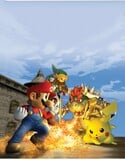
Expansion of Zelda related content. Talk about Sheik, Zelda, Ganondorf, and Young Link. Talk about how the game was first introduced at E3, with Mario dueling Link. Are there Event Matches involving Mario and Zelda? Talk about Temple and Great Bay. Underground Maze is clearly based on Zelda dungeons. Bunny Hood introduced. The music.
- Newcomers
In addition to those listed below, Link returns in this game.
- Sheik –
- Zelda –
- Ganondorf –
- Young Link –
- Items
- Bunny Hood – an item from The Legend of Zelda: Ocarina of Time and Majora's Mask, in which it makes Link move faster if he wears it. In the Super Smash Bros. series, a user jumps higher and moves faster for a brief period of time.
- Stages
- Temple – a ruined temple in the sky. It is a large stage based on locations from Zelda II - The Adventures of Link.
- Great Bay –
- Enemies
All enemies appear in the Underground Maze in Adventure Mode and can rarely be released from containers during Versus Mode. The Legend of Zelda is one of three series to have enemies in the game, the other two being Super Mario and Ice Climber.
- ReDead – zombie-like clay enemies from The Legend of Zelda: Ocarina of Time. They attacking by charging at characters, leaping onto them, and slowly sucking out their health. They can be shaken off by mashing the controller buttons, after which they continue to walk around. If attacked for long enough, ReDeads eventually lie down on the ground. If left in this state, they eventually rise again, meaning that only further attacks are able to completely eliminate them. ReDeads that are killed have a chance of dropping a random trophy.
- Octorok – octopus enemies. In this game, they resemble their appearance from The Legend of Zelda: Ocarina of Time. They attack by spitting rocks at the fighters.
- Like Like – gelatinous tube creatures. If a character comes in contact with them, they will be swallowed whole, causing ten damage immediately. The Like Like continues to do damage to the character until they break free.
Super Smash Bros. Brawl
Shifted emphasis to Twilight Princess and The Wind Waker. Toon Link is a new fighter added late in development after being given the go-ahead on Sonic (maybe not important to mention that last part). Bridge of Eldin, Pirate Ship, and Temple. Deku Nut. Music.
Expanded Adventure Mode called the Subspace Emissary: in which Zelda and Peach are close confidants, Yoshi and Link initially team up, Link misinterprets Mario's defeat of the Zelda doppelgänger as an attack on Zelda herself (and vice versa). Ganondorf and Bowser join forces. Petey Piranha traps Zelda.
Newcomers
- Toon Link
Assist Trophies
- Tingle – When summoned, Tingle performs his "Kooloo-Limpah" dance and one of the five random effects will happen. These events include spawning multiple Hammers and Golden Hammers, having everyone under the effects of the Superspicy Curry item, making all the opponents slip for a few seconds, zooming the camera in on the character who summoned Tingle, or even doing nothing and flying away with his balloons. Unlike Super Smash Bros. Melee, this iteration of the character is based on his appearance in The Legend of Zelda: The Wind Waker.
Items
- Deku Nut – Like in The Legend of Zelda series, a fighter can throw a Deku Nut at an opponent to stun them for a few seconds. The blast radius can affect several fighters at once. The effect is similar to players breaking other players' shields (or their own). It is possible for the thrower of the item to also be stunned during the explosion of the Deku Nut. If players are in mid-air during the explosion, they will be blasted away, similar to Bob-ombs. Deku Nuts will also explode on their own if left alone for a while. If picked up and held, they will still explode after a short while, stunning the holder of the item.
Stages
- Bridge of Eldin –
- Pirate Ship –
Super Smash Bros. for Nintendo 3DS / Wii U
Super Smash Bros. for Nintendo 3DS and Wii U are uniquely the only installments of the Super Smash Bros. series to not incorporate any new Zelda fighters or exclude any of the ones from the previous title. Link, Zelda, Sheik, Ganondorf, and Toon Link all return. Due to the hardware limitations of the Nintendo 3DS, Zelda and Sheik are now independent characters that cannot transform into one another. For Zelda, her new down special summons the armored Phantom from The Legend of Zelda: Spirit Tracks, despite retaining her design from Twilight Princess. Neither title includes a narratively driven single-player mode where Zelda and Super Mario characters interact, but it does include multiplayer modes called Smash Run and Smash Tour in the 3DS and Wii versions, respectively, which incorporates enemies from both franchises in unique capacities.
Assist Trophies
In addition to those new, Tingle returns from Super Smash Bros. Brawl and exhibits comparable behavior when summoned.
- Skull Kid – This Skull Kid is the main antagonist from The Legend of Zelda: Majora's Mask, bewitched by the titular Majora's Mask.
- Midna – Midna is a major character and traveling companion from The Legend of Zelda: Twilight Princess. As an Assist Trophy, she attacks by grabbing fighters with her hair and throwing them. If no opponents are near her, she teleports to their location.
- Ghirahim – a reoccurring and cruel antagonist from The Legend of Zelda: Skyward Sword. When summoned, Ghirahim travels across the stage to slash his sword and throw swift, homing projectiles. He teleports to reach far off opponents when none are near.
Items
The developement staff saught the inclusion of a lot more Zelda items than those present in prior installments, recognizing that they are a big part of that franchise. All previous items in the series return, in addition to these new ones.
- Fairy Bottle – a healing item from A Link to the Past. When used, it heals up to 100% of the user's damage.
- Cucco – chickens that debuted in A Link to the Past that can be picked up and tossed. When it strikes an opponent or is attacked, it summons a huge flock to attack the offender.
- Bombchu – a mouse-like bomb from Ocarina of Time that scurries around the stage after being tossed, including walls and ceilings. It explodes when it makes contact with another fighter.
- Beetle – a mechanical scarab from Skyward Sword. It grabs onto opponents and lift them skyward, past the blast zone of the stage. If the player is at low damage and/or mashes enough buttons, they can break away from the Beetle.
- Gust Bellows – a bag of air from Skyward Sword that blows strong winds when fired. If discarded, the wind blows erratically in all directions.
Enemies
All enemies appear in Smash Run. In addition to those listed, ReDeads and Octoroks return and retain their behaviors from Super Smash Bros. Melee. The latter is derived from its appearance in The Legend of Zelda: Skyward Sword for this game. ReDeads also have a presence in Smash Tour.
- Peahat – flying plants that debuted in the first Legend of Zelda, hear appearing as they did in The Legend of Zelda: Ocarina of Time 3D. They float and release Peahat Larvae to fly directly toward the player character. They can also spin rapidly, during which they cannot be physically attacked while also dealing high damage.
- Stalfos – recurring skeletal enemies from The Legend of Zelda series, her taking their design from The Legend of Zelda: Ocarina of Time 3D. They walk slowly left to right and attack when the player gets close to them. They sometimes jump backward to reposition themselves. They can block the players' attacks with their shield, although they are vulnerable from attacks from above, below, or behind. There is additionally a slight moment where the Stalfos lowers its shield, allowing the player to attack from the front. The Stalfos attack with their sword, using a three-slash combo or a jump attack. The Stalfos also appears as an enemy fought within the Master Fortress in the Classic mode of Super Smash Bros. for Wii U.
- Bubble – flying skulls engulfed in flames, often with wings. They take their appearance from The Legend of Zelda: Ocarina of Time 3D. There are two varieties of Bubble: Red Bubbles and Blue Bubbles, which burn and freeze the player respectively on contact.
- Darknut – black knights that debuted in the original Legend of Zelda. They take their design from The Legend of Zelda: Twilight Princess. They can walk and jump either forward or backward, and they are notably durable and powerful. They are armed with a sword for attacking and a shield for blocking and reflecting attacks. After receiving enough damage, it loses some of its armor, but afterwards it is more agile and swift and can use its sword as a projectile. As they are boss enemies, Darknuts drop large stat boosts when defeated.
- Cucco – Alongside their appearance as an item, enemy Cuccos resemble their 2D sprites from The Legend of Zelda: A Link to the Past as opposed to the item's three-dimensional model. They wander around the area, and they are non-hostile to players until they take enough damage. Afterwards, the screen flashes red and the player is attacked by a swarm of Cuccos. No matter how much damage is dealt to them, Cuccos cannot be defeated. The trophy specifically about the Cucco enemy depicts them using a model instead of their in-game appearance.
Super Smash Bros. Ultimate
Super Smash Bros. Ultimate includes every fighter to have previously appeared in the series, including Link, Sheik, Zelda, Ganondorf, Toon Link, and Young Link from Super Smash Bros. Melee. This game abandons the perceived trend of ensuring Link, Zelda, and Ganondorf reflect their designs from the same Zelda title, with Link no reflecting his appearance in The Legend of Zelda: Breath of the Wild, Zelda reflecting her incarnations from The Legend of Zelda: A Link to the Past and A Link Between Worlds, and Ganondorf now resembling his future incarnation from Ocarina of Time.
Everyone is here. Talk a bit about World of Light, especially where it intersects between Mario and Zelda.
Assist Trophies
In addition to the Moon, Skull Kid, Midna, and Ghirahim return from Super Smash Bros. for Nintendo 3DS / Wii U. Tingle is the only Assist Trophy not to return, but he does appear on the MM stage.
- Moon – from The Legend of Zelda: Majora's Mask. When summoned, it appears in the background and slowly approaches the stage , burning up as it does so. Once it crashes into the stage, the surrounding fire deals repeated fire damage on opponents before disappearing in a white flash.
N-Gang
Mario & Zelda Big Band Live
Mario & Zelda Big Band Live is a series of two concerts held on September 14, 2003, at Nihon Seinenkan Hall in Tokyo, Japan. It featured arrangements of various pieces of music from the Super Mario and The Legend of Zelda franchises.
DVD and CD recordings of various pieces of music from the two concerts, titled Mario & Zelda Big Band Live and Mario & Zelda Big Band Live CD, respectively, were released in Japan. The DVD was bundled with volume 101 of Nintendo DREAM, which released on November 21, 2003,[9] and the CD was released on December 10, 2003.[10] Both releases feature largely the same tracklist, with one exception; only the CD release includes an arrangement of "Secret Course" from Super Mario Sunshine.
Triforce
Triforce is an system board co-developed by Nintendo, Sega, and Namco for arcade systems, named after the Triforce from The Legend of Zelda. This board is used for Mario Kart Arcade GP and Mario Kart Arcade GP 2.
Captain Rainbow
Captain Rainbow takes place on Mimin Island, a land inhabited by obscure Nintendo characters. In addition to Birdo and a few other Super Mario characters, the island is home to Crazy Tracy, a character from The Legend of Zelda: Link's Awakening. Like other elements of Captain Rainbow, this iteration of the character is greatly caricatured from her original appearance, and she is depicted here using her wiles to control interested men. This is implied to include Mario and Link themselves, who appear in portraits in her mansion.
Nintendo Land
StreetPass: Mii Plaza
NES Remix series
NES Remix, its sequel NES Remix 2, and their compilation Ultimate NES Remix feature challenges based on Legend of Zelda games. NES Remix has challenges from The Legend of Zelda, NES Remix 2 has challenges from Zelda II: The Adventure of Link, and Ultimate NES Remix has select challenges from both prior games. Additionally, each game's special Remix I, Remix II and Bonus stages sometimes involve items and characters from one game appearing in another game.
NES Remix has a stage where Link from The Legend of Zelda is the player character in Donkey Kong, in the 25m level. Link makes the level more difficult because he is unable to jump.
NES Remix 2 has more stages where concepts crossing over between games occurs. In Stage 1 of Remix II, Toad from Super Mario Bros. 2 has to defeat three Octoroks in a Zelda II: The Adventure of Link area. Stage 6 and Stage 10-4 of Remix II both involve Link from Zelda II: The Adventure of Link dealing with Mario elements. The first has Link in an underground area from Super Mario Bros.: The Lost Levels, where he collects coins. The second has Link in a second underground area where he has to defeat a Hammer Bro while four giant Boos in a wall formation approach from the left. Many stages in NES Remix 2 have Luigi appear to go with the Year of Luigi. These appearances do not affect the gameplay and are more of an easter egg. NES Remix 2 sometimes depicts sprites from different games interacting, such as in the Records Stage of Remix II.
Nintendo Badge Arcade
Nintendo World Championships: NES Edition
Common misconceptions
New Super Mario Bros. U and The Legend of Zelda: A Link Between Worlds were announced around the same time and the marketing material for both games highlighted purple masked rabbit characters, Nabbit and Ravio, respectively. It was widely assumed in the press that Ravio and Nabbit had some sort of intentional relationship to one another, but the staff for both games clarified that there similarities were coincidental.
Mario's father in The Super Mario Bros. Movie bears a resemblance to Talon, and some members of the press speculated that this was intentional. Executive producer Shigeru Miyamoto clarified in an interview that Papa Mario was based on unpublished conceptual artwork for Mario's family, and that the similarities to Talon were incidental.
Gallery
- Main article: Gallery:Link
Artwork
Zelda no Densetsu 4-koma Manga Gekijō (Link and Mamu)
Super Smash Bros. Melee (Sheik)
Super Smash Bros. Brawl (Zelda)
Super Smash Bros. Ultimate (Sheik)
Super Smash Bros. Ultimate (Skull Kid)
Super Smash Bros. Ultimate (Moon)
Super Smash Bros. Ultimate (Midna)
Sprites and models
Link icon in Super Smash Bros. Melee
Young Link icon in Super Smash Bros. Melee
Link in Super Mario Maker
Toon Link in Super Mario Maker
Totem Link in Super Mario Maker
Wolf Link in Super Mario Maker
Link in Super Mario Maker 2
Zelda in Super Smash Bros. Brawl
Zelda in Super Smash Bros. for Wii U
Zelda icon in Super Smash Bros. Ultimate
Spark in The Legend of Zelda: The Minish Cap
Chain Chomp in The Legend of Zelda: A Link to the Past
Chain Chomp in The Legend of Zelda: Four Swords
Chain Chomp in The Legend of Zelda: Four Swords Adventures
Fire Bar in The Legend of Zelda: A Link to the Past
Thwomp in The Legend of Zelda: Link's Awakening (Nintendo Switch)
Head Thwomp in The Legend of Zelda: Oracle of Seasons / The Legend of Zelda: Oracle of Ages
Stone Elevator in The Legend of Zelda: Link's Awakening
Podoboo Tower in The Legend of Zelda: Oracle of Seasons
Bomb Soldier in The Legend of Zelda: Four Swords
Mamu in The Legend of Zelda: Link's Awakening
Manhandla in BS The Legend of Zelda
Master Sword in Super Mario Maker 2
Yoshi Doll in The Legend of Zelda: Link's Awakening
The Goat's Letter in The Legend of Zelda: Link's Awakening (Nintendo Switch)
Great Force in Mario & Luigi: Superstar Saga + Bowser's Minions
Screenshots
BowWow, trapped in the Moblin Cave
References
- ^ The Legend of Zelda Japanese instruction booklet."4方向に手を持つ大型のパックンフラワー。手が減るごとに速い動きになる。ややつよい攻撃力を持つ。"(A four-limbed, jumbo-sized Piranha Plant. Speeds up with each limb lost. Possesses somewhat powerful offensive strength.)
- ^ Iwata, Satoru (2009). Wii interviews: New Super Mario Bros. Wii. Iwata Asks. Retrieved 29 Nov. 2024.
- ^ Iwata, Satoru (2007). Wii interviews: Super Mario Galaxy. Iwata Asks. Retrieved 7 Mar. 2012.
- ^ Iwata, Satoru (2010). Wii interviews: Super Mario Galaxy 2. Iwata Asks. Retrieved 12 Apr. 2021.
- ^ Madao Joestar (18 Jun. 2016). Mario Artist Paint Studio - Premade Images. YouTube. Retrieved 21 Sept. 2022.
- ^ Iwata, Satoru (2009). "Kirby and Chomps in Zelda." The History of Handheld The Legend of Zelda Games. Iwata Asks. Retrieved 29 Nov. 2024.
- ^ TCRF. Super Mario Sunshine. The Cutting Room Floor (English). Retrieved June 30, 2024.
- ^ Nintendo of Ameirca (August 4, 2014). Hyrule Warriors Direct 8.4.2014. YouTube (American English). Retrieved June 30, 2024.
- ^ MARIO & ZELDA Big Band LIVE DVD. VGMdb. Retrieved October 14, 2023.
- ^ MARIO & ZELDA BIG BAND LIVE CD. VGMdb. Retrieved October 14, 2023.

